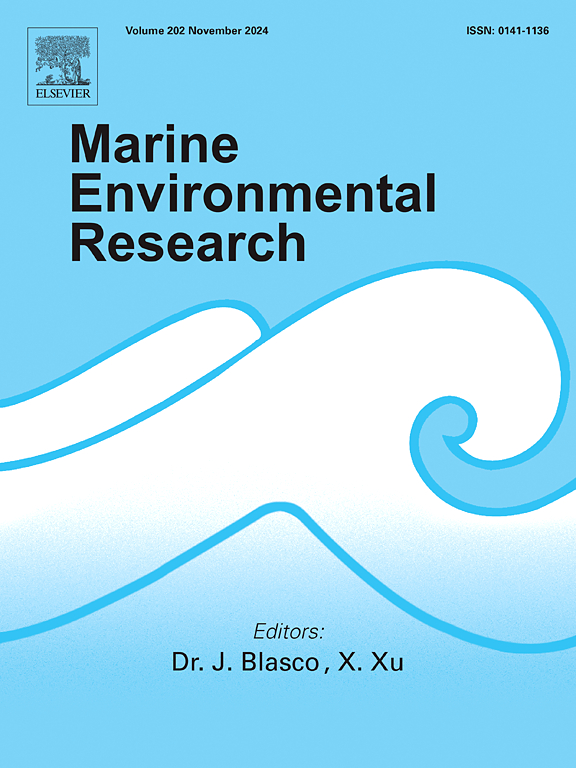盐度的大波动影响了楔石河口桡足类的生物量和生物量
IF 3.2
3区 环境科学与生态学
Q2 ENVIRONMENTAL SCIENCES
引用次数: 0
摘要
小型浮游桡足类动物在海岸大量存在,形成了食物网的基础。基于尺寸的标准化生物体积光谱越来越多地用于研究浮游生物和干旱的影响。生物体积是反映浮游生物特征和生物量的重要指标,但对河口高盐度环境下生物体积的研究较少。我们的研究估计了keystone耐受物种(如Oithona)的生物体积和生物量,以评估热带河口系统中盐度波动的影响。在极端干旱和短降雨期间,每两个月进行一次桡足类取样和盐度测量。我们发现轻度高盐度(~ 48和55)下的生物体积较高,中盐度和高盐度(~ 11和37)下的生物体积最低。除2月份生物量高而密度低外,生物量对生物量的响应基本一致。这些变化与桡足类对盐度波动的敏感性有关。因此,在较低的多样性和较温和的高盐度条件下,抗逆性物种在旱季茁壮成长。强降雨和短降雨带来的大量淡水输入对关键河口生物(如俄亥俄河生物)来说是一种干扰,它们在半干旱海岸的大部分时间里都面临着低水输入和高温。这导致这些生物在中盐和真盐状态下的生物体积和生物量减少。我们的研究结果表明,适度的压力条件有利于Oithona生物量,而极端环境条件(例如,间歇性洪水)超出了它们的承受能力,这为气候变化和极端天气事件如何影响河口种群提供了见解。本文章由计算机程序翻译,如有差异,请以英文原文为准。

Large salinity fluctuations affect the biovolume and biomass of keystone estuarine copepods
Small planktonic copepods are abundant on coasts, forming the basis of food webs. Size-based normalized biovolume spectra are increasingly used to study plankton and the impacts of droughts. Biovolume is a key indicator of plankton characteristics and biomass, but research on biovolume in estuarine hypersalinity is limited. Our study estimated the biovolume and biomass of keystone tolerant species (e.g., Oithona) to assess salinity fluctuations impact in a tropical estuarine system. Copepod sampling and salinity measurements were taken bimonthly over a year during extreme drought and short rainfall events. We found higher biovolume under mild hypersalinity (∼48 and 55) and the lowest under meso- and eusalinity (∼11 and 37). The biomass responded similarly to biovolume, except in February when the biovolume was high but density was low. These variations were linked to copepod sensitivity to great salinity fluctuations. In this regard, the stress-tolerant species thrived under lower diversity and milder hypersalinity during the dry season. Great freshwater input from heavy and short rainfall represents a disturbance to keystone estuarine organisms such as Oithona spp. that face low water input and high temperatures during most of the year in a semi-arid coast. This led to a reduction in biovolume and biomass of these organisms during meso- and euhaline regimes. Our findings suggest that moderate stress conditions benefit Oithona biomass, while extreme environmental conditions (e.g., episodic floods) exceed their tolerance, providing insights into how climate change and extreme weather events may affect estuarine populations.
求助全文
通过发布文献求助,成功后即可免费获取论文全文。
去求助
来源期刊

Marine environmental research
环境科学-毒理学
CiteScore
5.90
自引率
3.00%
发文量
217
审稿时长
46 days
期刊介绍:
Marine Environmental Research publishes original research papers on chemical, physical, and biological interactions in the oceans and coastal waters. The journal serves as a forum for new information on biology, chemistry, and toxicology and syntheses that advance understanding of marine environmental processes.
Submission of multidisciplinary studies is encouraged. Studies that utilize experimental approaches to clarify the roles of anthropogenic and natural causes of changes in marine ecosystems are especially welcome, as are those studies that represent new developments of a theoretical or conceptual aspect of marine science. All papers published in this journal are reviewed by qualified peers prior to acceptance and publication. Examples of topics considered to be appropriate for the journal include, but are not limited to, the following:
– The extent, persistence, and consequences of change and the recovery from such change in natural marine systems
– The biochemical, physiological, and ecological consequences of contaminants to marine organisms and ecosystems
– The biogeochemistry of naturally occurring and anthropogenic substances
– Models that describe and predict the above processes
– Monitoring studies, to the extent that their results provide new information on functional processes
– Methodological papers describing improved quantitative techniques for the marine sciences.
 求助内容:
求助内容: 应助结果提醒方式:
应助结果提醒方式:


